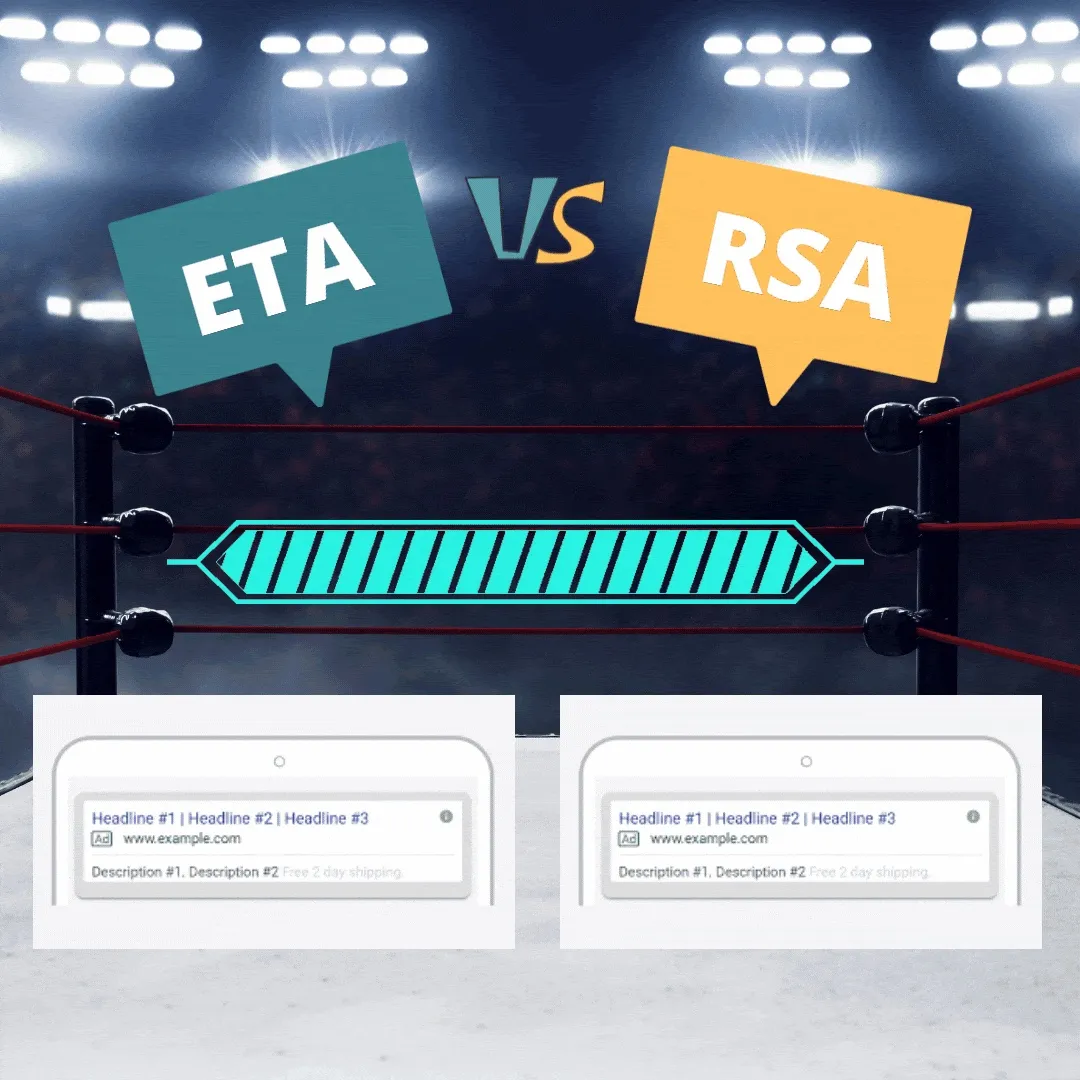read
In advertising, finding the right headline-description combination is one of the biggest challenges faced by advertisers. Responsive search ads resolve this hurdle. They save marketers the time and effort of developing smart bidding strategies and testing the best headline-description combination, as Google gets that done.
So, what are responsive search ads, and how can you use them to drive more leads? Let's find out.
What are Responsive Search Ads?
Responsive search ads (RSAs) are a modified version of traditional text ads that adapt to show more relevant messages.
Traditional text ad formats require a lot of testing and optimisation. Advertisers need to create multiple versions of the same ad using different headlines and descriptions. Google then rotates these multiple standalone versions as it sees fit. You can turn this option on in the Ad rotation section in your campaign settings.
Responsive search ads also require you to create numerous versions of an ad. But you don’t need to manually test these versions. Google does that for you.
In responsive search ads, Google considers each ad piece as an "asset" instead of viewing it as an individual ad version. Then, Google mixes these assets and shows the best combination of headline and body copy.
Responsive Search Ads vs. Expanded Text Ads: Are RSAs the New Default Ad Type?
So, how do RSAs compare to ETAs? Let's dig in.
For starters, expanded text ads allow up to three headlines and two descriptions only. The position of these elements never changes, thereby providing you with more control over your ad.

In contrast, responsive search ads allow you to create up to 15 different headlines and four descriptions. This clearly means more options, as you can fit numerous headlines and ad copies to cater to broader search queries. But on the downside, you can't control which headline and description combinations Google will show for a particular search query.
In all, ETAs offer more control, while RSAs provide more options.
Now, which one is better? The answer is: it depends. For advertisers who want a higher level of control and run granular-level campaigns, ETAs could continue to prove beneficial. For advertisers who need more flexibility and want to test multiple headlines and descriptions, RSAs can be a revolutionary adoption. It's best to test both Google ads and determine which ad format works the best for you.
How do Google’s Responsive Search Ads Perform?
Responsive search ads bring AI and machine learning to the advertising space. You create multiple headlines and descriptions, and then the AI does the rest by shuffling different combinations to show the best version to the consumers.
Fun Fact: 15 headlines and four descriptions can create over 40,000 unique combinations.
RSAs vs. ETAs Ad Performance Comparison
When compared with expanded text ads , responsive search ads:
drew an 11.7% higher cost per click
pulled traffic that bounced 4.9% less
had an 8.7% higher cost per acquisition
had a 26.3% higher CTR and better engagement
Overall, responsive ads have a higher click-through rate, convert more frequently, and attract traffic that bounces less often. While they have a slightly higher CPC, their CPA decreases over time.

The Pros and Cons of RSAs
While responsive search ads provide many features and functionalities, it'd be too early to say they're better than expanded text ads. They have their pros and cons that advertisers must keep in mind when using them.
Pros of Responsive Google Ads
More flexibility than a traditional text ad.
No need to go through the redundant task of testing your ad copies for multiple broad match keywords
Use cross campaign asset reporting to help you analyse your campaign's performance
Pinning headlines functionality – If you want to include specific headlines or certain text elements – such as your brand name – you can pin them to specific positions. This ensures that while several versions of your ad are displayed, they all carry the message you want to communicate.
In all, RSAs offer more flexibility, testing capabilities, and a broader wider reach.
Cons of Responsive Ad Format
More time consuming to set up than ETAs, as you need to create numerous headlines and description lines
Less control over how your Google ads are shown, and you have to rely on Google's algorithm
These drawbacks make responsive search ads less favourable for a gradual ad campaign structure.
Tips and Best Practices for Google Responsive Search Ads
Now that we have discussed the pros and cons of RSAs and how they perform, let's delve into the best tips and practices when using them.
1. Responsive Search Ads Perform Best with Multiple Headlines & Descriptions
As mentioned, RSAs allow you to include numerous best headlines and descriptions. Utilise that feature! You don't have to come up with 15 headlines and four descriptions for each asset but aim for at least ten headlines and three descriptions. The more combinations you try, the better chances you have of appearing in a user's search.
2. For Best Performance, Highlight Something Different in Each Headline & Description
Make sure that you don't create multiple headings and descriptions just for the sake of doing that. The headline and description line variants should be different. The chances are that Google won't even show your ad if the headlines and descriptions use similar phrases.
Of course, this step requires creativity. Try working around different value propositions, calls to action, and offers.
Suppose you’re selling gym shoes. You can create one ad highlighting the comfort and another ad outlining their durability and performance.
Working with a dedicated PPC agency will be helpful, as they have expert copywriters to help you with multiple effective headlines and descriptions.
Finally, have headlines and descriptions of different lengths. Avoid similar messages and try to offer a unique experience to the consumers with each ad.
3. You Can Pin Specific Keywords and Phrases in Headlines and Descriptions.
Leverage the "Pin to position" feature to make your Google ads more relevant. RSAs give you the option to pin certain keywords and phrases that you always want to appear in your headlines and descriptions.
This ensures that even though Google will show different headline-description combinations, the core message of the ad will remain the same.
For instance, suppose you're offering a flat 40% off on all your products. You might want to highlight that message in all your headlines and descriptions. Hence, you can pin "40% off," and Google will show it in all your Google ads.
4. Pin Very Sparingly!
While text pinning is an excellent feature of responsive search ads, please don't abuse it. If you pin headlines or descriptions too often, it restricts Google from automatically testing multiple variants of your ad.
In fact, pinning text in just one headline reduces the scope for testing by 75%. Therefore, it's always a good idea to use pinning sparingly.
5. You Can Keep Your Expanded Text Ads
Keep these two things in mind:
Google isn't planning on discontinuing expanded text ads anytime soon.
RSAs and ETAs are not rivals; they are buddies.
If you want to use responsive text ads, that doesn't mean you have to get rid of your expanded text ad campaigns. If your active ETAs are performing well, you can keep them running while testing new RSAs.
Google also encouraged businesses to keep running at least one ETA in each ad group alongside new responsive ads. By running ETAs and RSAs simultaneously, you can ensure that your Google ads appear in multiple searches and reach more potential customers.

6. Test Only One Responsive Search Ad Per Ad Group
Testing the ad group performance of multiple ad groups can be tempting. Google automatically tests various elements of your ads, so it isn't essential to include multiple ads and ad extensions in the same ad group. Limit yourself to trying only one responsive search ad in each group, as doing more can affect the optimisation of your ads. When you test more ads for a single audience group, it can lead to inconsistent data.
7. Use Your Top-Performing Static Google Ads to Come Up with RSA Assets
Remember we discussed that you shouldn't get rid of your text ads? You can use them as a base for your responsive text ads. Examine the ad performance of your static ads and identify the top-performing ads.
Then, pick elements for headlines and descriptions from those Google ads and use them in your responsive ads. Pick value propositions, calls to action, and offers that are working for your text ads, and try using them for your responsive search ad campaigns.
Conclusion: Should RSA be your Go-to Ad Type?
Responsive search ads make advertising easier. They help you streamline account management by letting you test more headlines and descriptions and finding which combinations perform the best. This helps you reach more consumers and improve account performance.
However, advertisers shouldn't see RSAs as a replacement for expanded text ads. Google suggests that you use RSAs alongside ESAs for improved performance of your Google ads.
If all this talk about RSAs and ETAs makes your head spin, or you’re ready for better results, get in touch with Optimum Click today. Our ad experts have years of experience helping companies just like yours build their brands and revenue through PPC advertising.


![AI Advertising in 2025: Real ROI vs Expensive Hype [Guide]](/_ipx/f_webp/img/blog/blog-ai-in-the-advertising-space.jpg)
